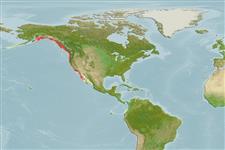Common names from other countries
Classification / Names / Names
Common names | Synonyms | Catalog of Fishes (gen., sp.) | ITIS | CoL | WoRMS
Environment: milieu / climate zone / depth range / distribution range
Ecology
Benthic; depth range 0 - 229 m (Ref. 822). Subtropical
Eastern Pacific. Tropical to temperate.
Length at first maturity / Size / Weight / Age
Maturity: Lm ? range ? - ? cm Max length : 20.0 cm TL male/unsexed; (Ref. 822); common length : 8.0 cm TL male/unsexed; (Ref. 312)
Body is oval. Coarse bumps called tubercles cover the body. It is orange-yellow to light yellow with dark brown to black blotches between bumps on its back. Gill plume is white and near the rear end. It has a fruity odor that seems to discourage predators.
Assumed maximum length from Ref. 822. Habitat: Found in the low intertidal to subtidal zone. Diet: sponges and detritus (Ref. 312).
Life cycle and mating behavior
Maturity | Reproduction | Spawning | Eggs | Fecundity | Larvae
Members of the order Nudibranchia are simultaneous hermaphrodites. Mating behavior: Both individuals darts their penis toward each other to induce one to act as a male and the other as the female. The victorious one to penetrate the body wall is the dominant male. Life cycle: Eggs are deposited on a substratum where they develop and hatch into (planktonic) vestigial veliger larval stage and further grow as adults.
Gallivan, G. and J. Danforth. 1999. (Ref. 312)
IUCN Red List Status (Ref. 130435)
CITES status (Ref. 108899)
Not Evaluated
Not Evaluated
Human uses
| FishSource |
Tools
More information
Age/SizeGrowthLength-weightLength-lengthMorphologyLarvaeAbundance
Internet sources
Estimates based on models
Preferred temperature
(Ref.
115969): 4.6 - 22.6, mean 8.5 (based on 104 cells).
Vulnerability
Low vulnerability (10 of 100).
Price category
Unknown.
